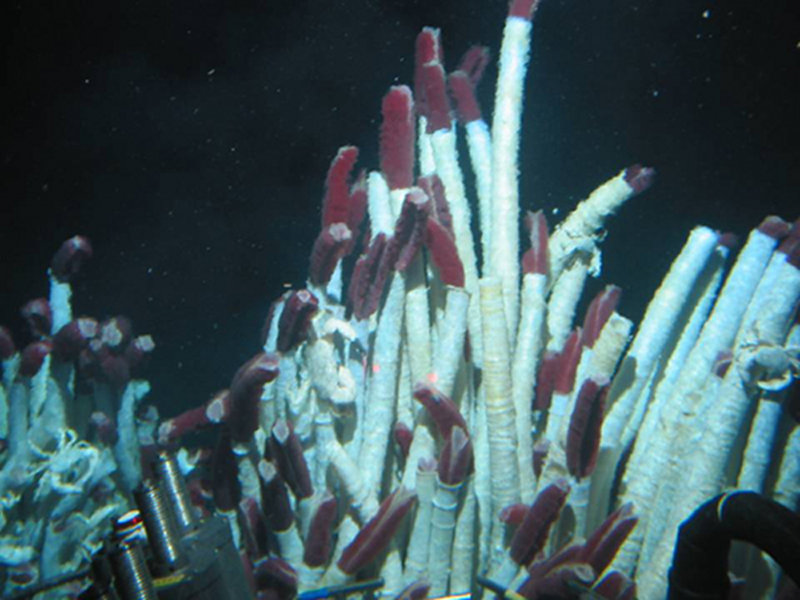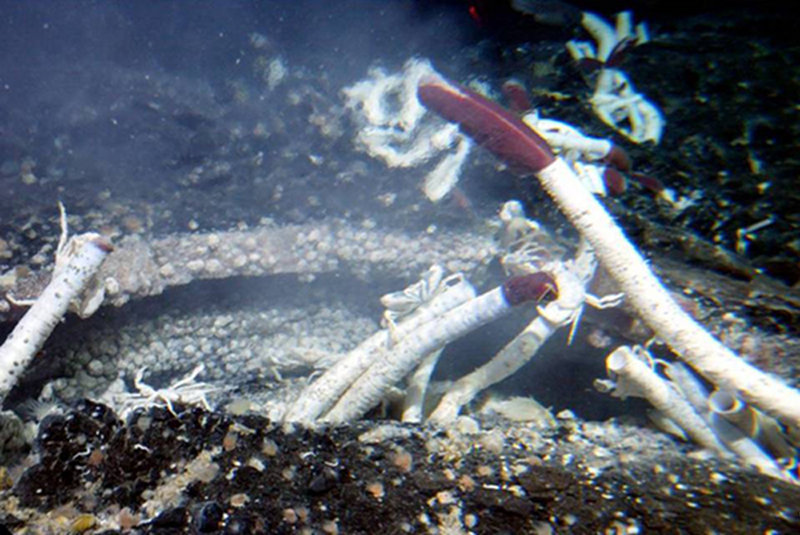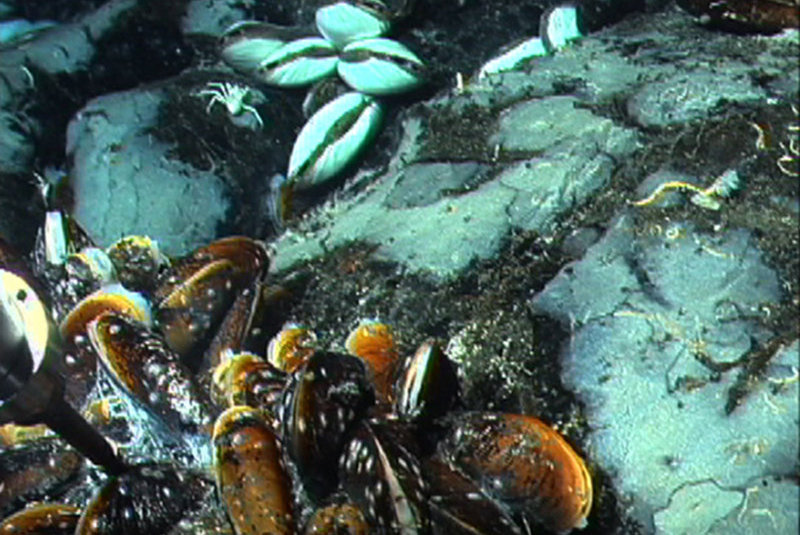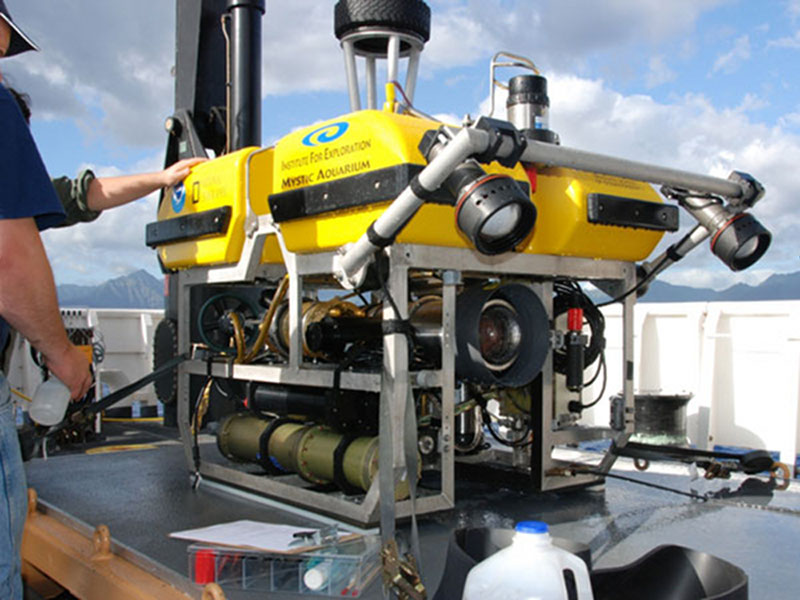
By Lonny Lippsett, Woods Hole Oceanographic Institution
In the beginning, there was the Garden of Eden. It was a lush primordial oasis of life, but this one was on the bottom of the ocean. Now, we have embarked on an expedition to return to the Garden and to explore other nearby communities of exotic deep-sea life.

The Garden of Eden vent field as seen most recently by Alvin in 2005. This site, hosting Riftia tubeworm tubes, greater than 10 feet in length (shown here), was among the first to be discovered along the Rift, and as of 2005, has been active for more than 20 years. Image courtesy of Tim Shank, Woods Hole Oceanographic Institution, NOAA OE. Download larger version (jpg, 1.8 MB).
The Garden of Eden was named by scientists diving in the submersible Alvin near the Galápagos Islands in 1977. They were astonished to see fields of slender, 6- foot-tall, white tubes with the blood-red tips of worms peeking out. Like flowers atop tall stems, they swayed in the shimmering breeze of warm fluids venting from the seafloor. The discovery of life thriving in the absence of sunlight and nourished by chemicals in the vent fluids revolutionized understanding of how and where life could exist.
Since vent life was found on the Galápagos Rift, oceanographers have found that various animal populations live in different regions of the seafloor. “You can think of these deep-sea communities along the mid-ocean ridge like cities connected by an interstate highway system,” said Tim Shank, a deep-sea biologist at Woods Hole Oceanographic Institution who will be aboard Okeanos Explorer. “The populations in San Diego, Minneapolis, Boston, and Miami, not to mention London, Cairo, and Tokyo, are markedly different, and so are animal populations on different segments of the mid-ocean ridge and even along the same segment.”

Rosebud vent site as seen during its discovery in 2002. The largest Riftia tubeworms shown here, all less than 2 feet-tall, colonize diffuse vent habitats between broken pieces of fresh lava. Image courtesy of Tim Shank, Woods Hole Oceanographic Institution, NOAA OE. Download larger version (jpg, 868 KB).

The Calyfield clam field was the western-most known vent field on the Galápagos Rift when discovered 89.6°W. Image courtesy of Tim Shank, Woods Hole Oceanographic Institution, NOAA OE. Download larger version (jpg, 445 KB).
Along a section of the mid-ocean ridge called the East Pacific Rise, which separates the Pacific Plate and the Cocos Plate to the east, scientists have found more than 160 species of worms, crustaceans, and mollusks. The Galápagos Rift is the border between the Cocos Plate and the Nazca Plate to the south. At the Garden of Eden and seven other vent sites discovered between 86°W and 89.5°W along Galápagos Rift scientists have found fewer than 60 species, but many of these are not seen anywhere else.
For more than two decades, scientists have theorized that the Hess Deep, a chasm at the juncture of the Pacific, Cocos, and Nazca Plates that plunges 9,000 feet deep, might act as a formidable barrier blocking the dispersal of larvae of deep-sea animals, Shank said.
A second strong theory is that animal communities are determined by different types of vents found in different areas. On the East Pacific Rise, scientists have found “black-smoker” vents, which billow out powerful jets of dark, mineral-rich, fluids reaching temperatures of 350°C (660°F) under deep-sea pressure. No such sites have been discovered yet along the Galápagos Rift, where fluids with temperature less than 35°C (95°F) waft from the seafloor.
In 2005, however, a research cruise on the Galápagos Rift to the west of the Garden of Eden between 89.5°W and 94.5°W found evidence of three areas with black-smoker vents. Scientists christened them the Navidad, Iguanas, and Penguinas Vent Fields. That has sparked another theory: At 91°W, a large fault offsets the Galápagos Rift like the middle segment of a “Z.” The newly found high-temperature vent sites are north of the zag; and the older low-temperatures vent sites are on the other side of it to the south. Does this fault act as a border between different volcanic activity and/or as a barrier for larval dispersal?

The 2011 expedition will explore black smoker areas using the Institute for Exploration’s Little Hercules ROV. Image courtesy of NOAA Office of Ocean Exploration and Research. Download larger version (jpg, 703 KB).
The 2005 expedition offered only a brief encounter and tantalizingly glimpses of animal life at the new block-smoker vent sites, including giant tubeworms and dinner-platter sized clams and mussels. To get a much closer look, the 2011 expedition will explore these black smoker areas using the Institute for Exploration’s Little Hercules ROV. Via its fiber-optic cable attached to the ship, scientists will be able to control the vehicle’s navigation precisely. And like a mechanical optic nerve, the tether will transmit real-time images to scientists.
During the few days of water column surveying during Leg I of the expedition,it appears that the Rift from Calyfield to at least Rosebud has become very hydrothermally active. There are four areas with strongly reduced chemicals in the water column over this 130 miles stretch of seafloor. In fact, given the data, we may have black smokers in an area that has not had them before. Seafloor exploration of these may reveal recent volcanic eruptions and hydrothermal activity- a testimony to the dynamic mid-ocean ridge system. For now, we don’t know at this point.”
The expedition aims to find out and with our streaming of live video directly from the seafloor, the world can take part in the discovery as it happens.